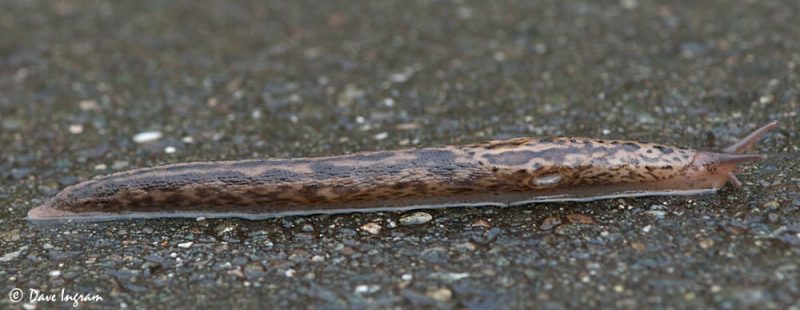
Slugs are notoriously hard to photograph – the challenge is to have enough depth of field (area of the image in focus) that both the near eye spot and the body are sharp and crisp. Since slugs are often prefer to avoid full sun you end up trying to capture an image in low light conditions with a moving (albeit some slowly) subject. I prefer to use natural light but have been thinking that perhaps a specialized flash for macro photography might be a good idea.
On my walk to the Courtenay estuary today I came across a giant gardenslug (Limax maximus) crossing the asphalt walkway and quickly took a couple of photographs before being forced to move on by my three year old and one and a half year old in the stroller who were starting to take off their shoes and socks in protest for the lack of movement. I wasn’t confident about getting sharpness in the eye of the slug and back home didn’t have a single shot that was perfect. Ah well, it’s a slug so one can’t complain.
The giant gardenslug is an introduced slug that is native to Europe, Asia Minor and North Africa. It is generally nocturnal (I guess the day was dark and gloomy enough to entice it out) and can be found in gardens and suburban woods. Look under rocks and wood to locate it during the day. At night it emerges to eat fungi and decaying vegetation, returning to it’s shelter spot by daybreak.
This is a distinctive looking, large grey/brown slug which can reach a length of 10cm or more. Its back is mottled with black spots that often merge into long irregular black stripes. The mantle is also irregularly spotted (never banded) and has a noticeable pattern of ridges that looks a little like a fingerprint. Tentacles are a reddish-brown in colour. If you pick this slug up (and you know that you want to!), the sole is a creamy white. The mucus is colourless.
While I didn’t get the ideal image that I was looking for I was happy to see a slug that was a little different from the usual suspects, even it was an introduced species. I didn’t see it on my way back so it must have moved on. I hope that I’ll run into it again when I have a little more light and a little more time!
Slug enthusiasts who want to learn more about British Columbia slugs should check out Robert G. Forsyth’s excellent book Land Snails of British Columbia.